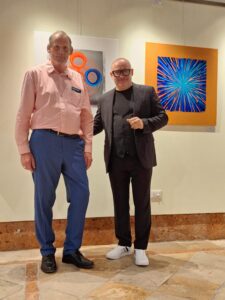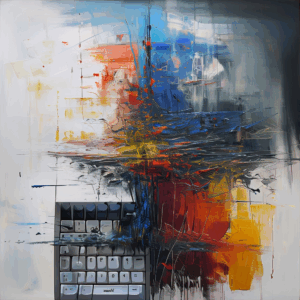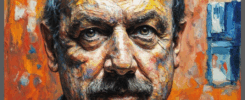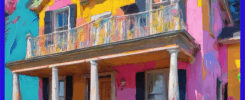Faceless in the Art Scene – Why Visibility Isn’t Enough
An Essay by Konrad Wulfmeier, Artist
When I step out of my studio and send my works into the digital world, I ask myself: Will they drown in the flood of images? Are they just another pixel in an endless sea of transience, a blink that leaves no trace? We live in an era where visibility is considered the highest virtue. Artists optimize algorithms, adapt to trends, and fight for seconds of attention. But what does it mean to be seen if no one remembers?
The digital art scene faces a quiet paradox: It is visible – but often faceless.
The Paradox of Visibility
In today’s social feeds, we encounter millions of images. Perfect compositions, precise linework, flawless color schemes. Yet something essential is often missing: a voice, a stance, a heartbeat. AI-generated artworks, NFTs, and visual experiments flood the platforms in an eerily uniform wave. The works are technically brilliant – and yet soulless.
color schemes. Yet something essential is often missing: a voice, a stance, a heartbeat. AI-generated artworks, NFTs, and visual experiments flood the platforms in an eerily uniform wave. The works are technically brilliant – and yet soulless.
I recall an exhibition I visited recently. The works were impressive at first glance, technically impeccable, almost hypnotic in their perfection. But they left no resonance. It felt as if the images floated on the surface – without ground, without depth. When I asked the artist what had inspired him, I received a sterile answer. No emotion, no intention. Instead of a narrative, I heard phrases that sounded more like a press release. There was plenty of image – but no face.
What Makes Art Tangible?
A work doesn’t come alive through visibility, but through the traces it leaves in the soul. The imperfect brushstrokes, the deliberate asymmetry, the palpable texture of a medium – these are expressions no AI can replicate. They are what make art human.
Yet we stand at the dawn of a new era. QuantumNature-Art is the bridge between tradition and technology – between human intuition and the precision of AI. In my work with QuantumNature-Art, it’s not about using AI as a mere tool. I seek dialogue. I pose questions to the machine that it cannot answer, and in this tension, works emerge that carry both my signature and the complexity of the machine.
I ask: What happens when machines want to believe? What does spirituality mean in synthetic systems? How does our concept of nature change when it is digitally reconstructed?
Artistic identity arises when technology meets conviction. Where aesthetics are not just surface, but a resonance chamber for thoughts, emotions, and existential questions.
AI Art: Between Output and Expression
Art created through AI is full of potential – and full of conformity. Many works are technically brilliant but conceptually hollow. The difference lies in intention. AI can produce, but not feel. It can calculate, but not dream. Only an artist who brings conviction and emotion into the technology can create works that are not only seen, but felt.
but conceptually hollow. The difference lies in intention. AI can produce, but not feel. It can calculate, but not dream. Only an artist who brings conviction and emotion into the technology can create works that are not only seen, but felt.
Paths Out of Facelessness
How can artists remain visible in a world full of images without losing their soul?
Curate consciously: Create series with a clear narrative, where each work is part of a larger story.
Speak about your art: Essays and statements are not side notes. They give your work depth and a voice. Share your thoughts, your inspiration, your intention.
Collaborate across disciplines: Seek dialogue with other fields – philosophers, musicians, dancers. Art thrives on exchange and new perspectives.
Show conviction: Art is never neutral. Stand up for issues that move you – socially, spiritually, or ethically. Let your works speak.
I believe that true art is more than what we see. It is what we feel. It is the connection between visibility and resonance. Facelessness is not a fate – it is a choice. And I choose depth, discourse, and authenticity.
by Konrad Wulfmeier Master Code – When Art Becomes Tangible

